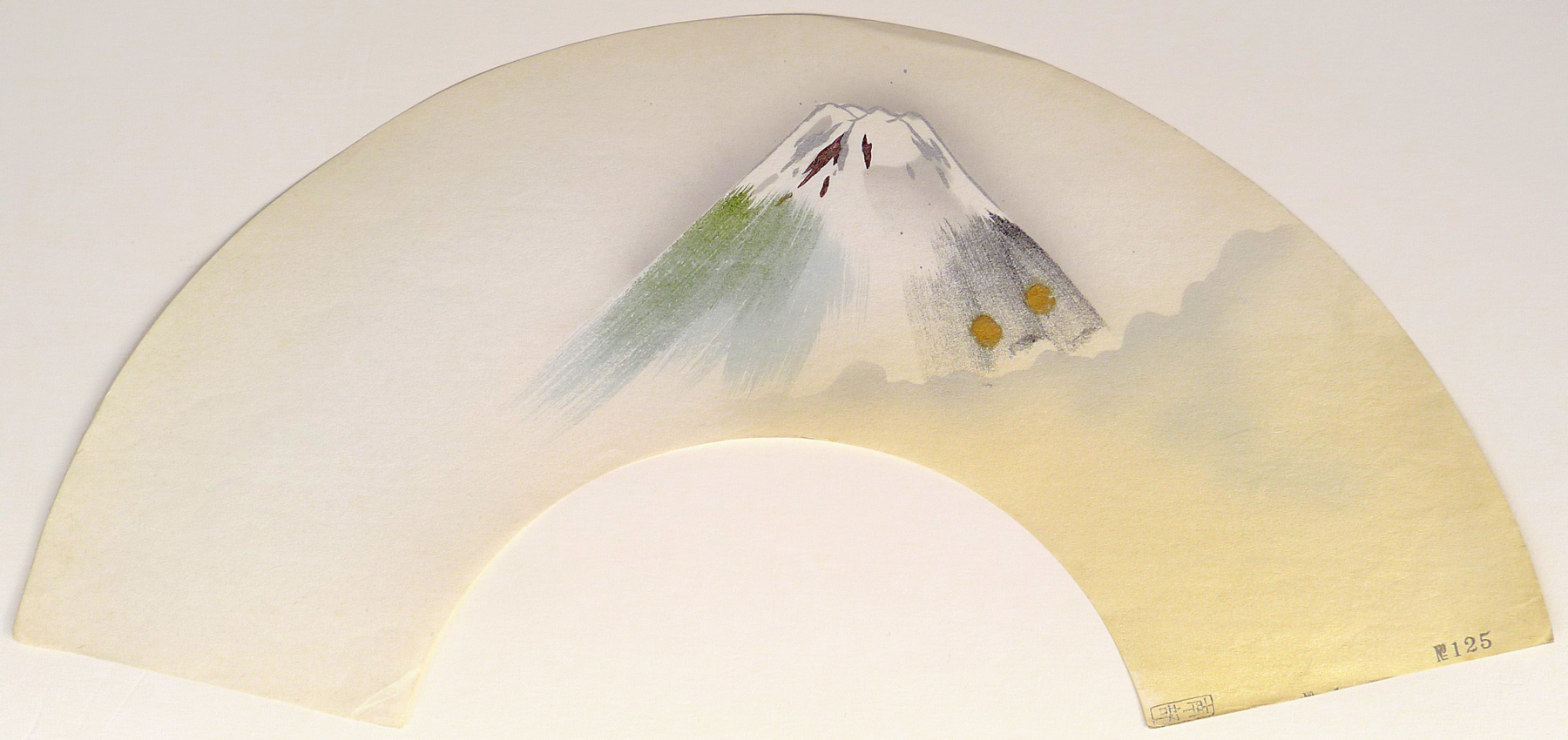Fan design samples were created as marketing tools for deluxe fan makers. While the fan design samples below were likely created in the Taishō and early Shōwa eras (c. 1912-1940), fan design samples date back to the Meiji era. They showed the season's available designs, commissioned from some of the most eminent artists of the day. Once the season was over, the sample fans and books of fans were sold. Most of the samples in my collection do not carry a signature or seal and the artists will be forever unknown, but some famous names do appear on several of the prints, such as the below prints Fish and Reeds, designed by Fukuda Heihachirō [福田平八郎 (1892-1974)], a nihonga painter who was awarded the Order of Culture, and Leaping Fish designed by Yokoyama Taikan [横山大観 (1868-1958)], another famous nihonga artist and Order of Culture winner.
The designs range from Art Deco to traditional genre scenes.
The shape of these prints indicate they were designs for folding fans (sensu 扇子, or ōgi 扇 as they are also known.) While often described as "woodblock prints", I believe most of these sample designs are hand painted or inked rather than printed, as on at least one sample a brush hair is embedded in the ink/paint and on several others the ink or paint has overlapped the paper edge and bled onto the back of the paper.
Some of the prints carry inventory numbers; some bear a cartouche with the word nambu (literally, "southern region" and possibly the name of a company) written in kanji 南部 or kana なんぶ, and some bear a fan-shaped cartouche with the kanji character 業 ("karma" or simply the character for "industry" or "business") inside it, possibly the trademark of another fan company.
| IHL Cat. #1731 | |
IHL Cat. #1760 |
History of the Folding Fan
The folding fan (Ogi) as opposed to the much older fixed or flat fan (Uchiwa) is popularly thought to have originated in Japan around 670 A.D. made of wooden or bamboo strips threaded together and secured by a rivet or pivot. The oldest surviving wood strip fan (Hi-ogi) was discovered in Nara City, Japan dating to 747 A.D., while the oldest known Chinese or Korean folding fans of a similar type date to the 10th Century A.D..
Paper production technology arrived in Japan from China in 610 A.D., paper may have been imported before this date. Remains of the oldest surviving paper folded fan were found in Akitsu, Japan and can be dated to the late 11th century/early 12th century A.D..
While it is not known when paper folding fans were first made the oldest reference to a paper folding fan (Kawahori – bat wing) appears in “Relationship with Japan of the Song History” written in 988 A.D., when it lists gifts including Kawahori and Hi-ogi from Japan to the Song Dynasty. Showing the status, at this time, of the fan in Japan to be considered suitable as gifts for royalty.
Japanese folding fans are supposed to be closed whenever possible and may be opened only when necessary, they did not start as decorative art or craft items but instead were an information device and are still used as such in Japan today.
Originally only used by the aristocracy and Samurai classes fans were not just a practical device used to keep cool but due to their easily portable form they evolved from being used as a simple writing material to be used for communication, instructive educational tools, recording or writing instruments, symbols of status, decorative and fine arts and even as weapons.
There are many examples of fans containing important information such as rules; regulations; Court orders, decisions and announcements; letters; calendars; schedules; prayers, medical transcriptions; text books for education, maps and so on. It is only in the later period that a folding fan developed more as an object of art or decorative art. Japan became famous for the quality of their fans and surviving records show large numbers being exported to China by the 15th century A.D.. As their popularity grew not just amongst the aristocracy and Samurai classes records show the appearance of professional fan painters and makers and centres of production became established such as in Kyoto.
By the 15th century A.D. folding fans had been introduced to Europe through trade and the Silk Road where they were received as an art form and object of decorative art. Originally a status symbol for royalty and the aristocracy they soon gained a much wider popularity and by the 18th and 19thCenturies A.D. in Europe ladies of all social classes carried a folding fan in their daily life as a decorative and sometimes practical ornament again with a host of uses and meanings.
This popularity was reflected in European artworks with many examples appearing in paintings by the Impressionist School, reaching a height of popularity in the Art Deco period. Reflecting this was the export of fans from Japan to Europe and America in 1920 A.D. of almost 4,420,000. |
|















































